
THE THOUGHTS ARE THE STRENGTH OF MY MUSCLES.
—PRENTICE MULFORD
Once you can do 5x5 full range Hardstyle sit-ups, how do you progress?
Certainly not by adding reps and not by adding weight either. The answer is trying to tense your muscles harder. Several years ago Steve Maxwell suggested to the trainees doing modified Janda situps: “Don’t see how many reps you can do, see how few you can do!” Indeed, the higher is the tension, the quicker the onset of fatigue. So the stronger you get, the quicker you get gassed. After just one or two I am toast. Whatever reps you manage, if you feel that the tension is about to drop off—you are done. This is the mindset of strength—the opposite of the mindset of endurance—to give it all at once.
This is a good time to stress that the Hardstyle sit-up is an exercise and not a lift and you should not compare your numbers to someone else’s—or even to your own for that matter! Find some other way of evaluating your abdominal strength progress if you must—say, the L-seat on parallel bars for time or the number of consecutive hollow rocks—but don’t chase any sort of numerical improvement in your Hardstyle sit-up.
Back to progression. There are several reasons why I don’t like adding weight to forward flexion exercises. In the case of Hardstyle sit-ups, physics will not allow you to add much—you would just tip over. And in the case of Swiss ball crunches, regular sit-ups, and the like, I don’t care for the logistical challenge. Paul Chek has used over 200 pounds in the former. A manly effort in an effective exercise. If you are willing to put up with the hassle and have a reliable ball and spotter—power to you. I will pass, I am lazy, I am Russian.
Powerlifter Bruce Anderson decided to get serious about his abs. He started doing straight-legged sit-ups with a 25-pound plate. Five years later he was up to 435 pounds of plates for a set of 10! Another effort worthy of admiration but I am not so sure about emulation. Again, I have nothing against the exercise or its effectiveness, I am just dreading dealing with all these wheels.
I would make an exception for the hanging leg raise—snapping on a couple of ankle weights is not as bothersome as piling hundreds of pounds on your chest—but since most athletes cannot even do a single rep of the proper HLR unweighted, this is mostly theoretical. Besides, even studs can find plenty of challenging HLR variations without adding weight.
It is not that I don’t believe in adding weight—I just think it is not worth it. Save those wheels for your deadlifts. And in the case of less than elite athletes loading up is pointless: adding weight to crunches made no difference in ab recruitment in female college students.40
So if we don’t add reps or weight, what is the alternative?—Increasing the intensity of contraction.
Scientists differentiate between external isometrics and internal isometrics. “The former refers to isometric contraction exerted against an external load, whereas the latter refers to contraction exerted against opposing muscles within the body, much like muscle posing actions performed by bodybuilders.”41 In my opinion, the impressive abs you see on the top guys are not the result of their high rep crunches but of their posing. They also know how to develop a “mind to muscle link” and really focus on squeezing those abbies. As should you.
Prof. McGill, when teaching his patented “McGill curl-up” to elite athletes, instructs: “Even the most serious athletes can increase the challenge… to ultimate training levels. First, a pre-brace is performed by the entire abdominal wall. It is maximally activated—neither sucked in nor blown out. The secret is to curl… against the abdominal brace in such a way that the large resistance is provided by the activated abdominals…”
In addition to the obvious resistance of the “bubble” of intra-abdominal pressure created by Hardstyle breathing42—you are fighting your own lower back muscles. It is fascinating that increasing the IAP reflexively makes the spinal erectors contract “vigorously”, even in full flexion.43 At McGill’s lab my lower erectors reached 80% peak activation during a variation of the Hardstyle breathing drill practiced by Russian boxers—while they barely passed 55% when I was deadlifting 80% of the max I was capable of at that time! No wonder Hardstyle sit-ups are so hard—you are fighting the resistance of your very strong lower back muscles. Who needs extra weight?
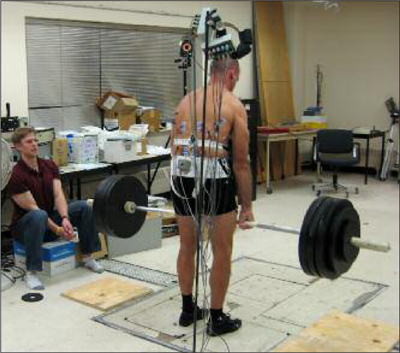
A Hardstyle breathing drill made the lower back muscles contract a lot harder than a 405-pound beltless deadlift! Courtesy Prof. Stuart McGill’s Spine Biomechanics Lab at the University of Waterloo, Canada
In addition to straining against the brace and the bubble simply try to maximally tense all of the muscles of the abdominal wall. A variation of internal isometrics is the unfortunately forgotten “muscle control” method, which requires one to maximally contract individual muscles using nothing but will power. One of its most famous practitioners, European strongman and physique man Maxick, recalled his amazing transformation:

In my daily association with my schoolmates I was always the weakest in our play activities. My natural boy’s feelings rebelled against the superiority of the others and the desire grew in me to become far stronger than they… I with the assistance of several friends managed to make a stone dumbbell. This crude dumbbell, however, had only a short span of life. My father, who neither knew nor approved of my secret plans, smashed it into a thousand pieces. However, I was far from allowing myself to be discouraged by this and other setbacks in the future. At night, when all other members of my family abandoned themselves to refreshing sleep, I remained awake in my bed and tried to replace the demolished dumbbell by tensing and relaxing different muscle groups.
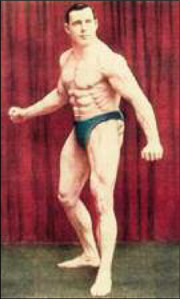
I very soon learned that the important factor was the inspiration of determination in performing an exercise and not merely the number of repetitions. With this I want to say that I did not put any special value on a high number of mechanical repetitions but that I combined every individual movement with the conscious sensing of a strengthening of a certain group of muscles. Through this process the entire attention flowed into the muscles active at the moment and the inner expectation of a strengthening resulted in an advantageous change of the physique.
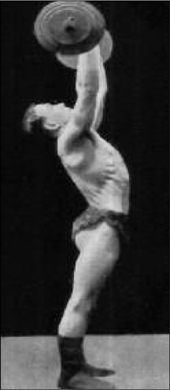
It is known that everything men have created has first been shaped and imagined in the idea and in thoughts. The strength, however, which is necessary for the materialization of a thought is the intensity with which we inspire that thought and with which we finally mold it into a form perceptible to the senses.
Dan Cenidoza, RKC who implemented muscle control into his training regimen several years ago with great success, muses, “I am no longer sure about the cliché, “Your body knows movements not muscles.” I see no reason that you cannot know both. I understand why people say that, to encourage new trainees to think of exercise in terms of movements instead of bodypart muscle building, but if movements are a skill, that makes both muscular contractions and the neural counterpart that drives it a skill as well.” Well said, Comrade.
This focus on the muscles works. Fellow strongman Tromp Van Diggelen had more than a few words to say about Maxick and his ability:
No photograph can do him justice, he has a “quality” of muscle which is absolutely unique. When contracting his muscles, he looks like an anatomical chart, yet when I used to massage him… his muscles felt like soft wet chamois leather in my hands.
…Max, who usually weighed under 140 pounds in his musichall performances, would invite any heavy man in the audience who would like to be lifted to come on the stage. This human dynamo would even take a 240 pound man, apply his open palm to the man’s lower spine, get the man to grip his (Max’s) wrist with both hands, then he would hoist the cumbersome human dumbbell to his shoulder using his left hand to help and then without any fuss push him to arm’s length (using the one arm only) and walk off the stage with him.

Here is another feat of speed and almost atomic energy which [Maxick] accomplished laughingly: He would take an empty champagne bottle, fill it three quarters full of water, grip it tightly by the neck with his left hand and then give the open mouth a smart tap with his right palm; he never failed to knock the bottom out, except when the bottle just collapsed in a general way. Just get a hold of a champagne bottle and try this feat, it will give you some idea of the unusual dynamic strength my buddy had…
…Max side pressed me (185 pounds) above his head supporting me (on my back) on his open palm, no less than 16 times; in his left hand he held a glass of beer filled to the brim with his arm stretched at right angles to his body and he did not spill a drop!... Here is just another “stunt” that even Saxon would have found hard, I used to lie with my back on Max’s open palm and he would tell me to close my eyes and it is honestly true that I would not know I was at arm’s length until he told me to open my eyes.
To show the terrific strength of his abdominal muscles Sick used to lie flat on stage and I, or some other 180 or 200 pound man, would stand 7 feet above him and jump on his abdomen; believe me, I bounced as if jumping on to solid rubber! You mathematicians can work out with what force the feet of a 200 pound man would strike Max’s rectus abdominis when falling from a height of 7 feet.44
[Maxick] ‘commanded’ (that is the word for it) each muscle of his body. His will seemed to act as commander-in-chief… A famous anatomist once said to me: “When Sick does feats of strength he actually seems to exceed his physical powers” and it is true that his mental concentration is something phenomenal… the ‘quality’ of his muscle is such as I have never seen before or since and I have examined many hundreds of real strong men.”

In addition to developing world class strength Maxick carved a physique defined beyond belief. Eugene Sandow himself conceded: “…this man has reached absolute physical perfection in physical development and that in my opinion he could not be improved upon.”
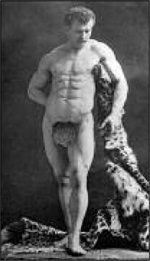
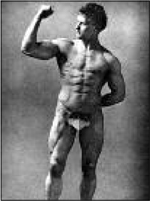
Eugene Sandow
Power to the People! www.dragondoor.com/b10
I hope you are convinced that directing your attention to squeezing your abs harder will make you strong and look the part. Here is an additional benefit to consider. I have explained the benefits of feed-forward tension—the skill of getting super tight before one’s body is loaded—in Power to the People! and The Naked Warrior. Powerlifters, arm-wrestlers, and gymnasts are masters of feed-forward tension because isometrically pre-tensing the muscles before a dynamic contraction can improve one’s performance by up to 20%!45
Rif explains:
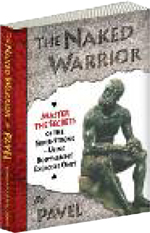
The Naked Warrior www.dragondoor.com/b28
This is feed-forward tension, the real domain of the gymnast. What makes gymnasts look like they are moving so effortlessly is the fact that they can get tight and stay tight as long as they need to. When you see “form” breaks on a gymnast, what you are seeing is the lack of the athlete in keeping his body tight. In order to do these incredibly complicated movements (or even simple ones like handstands) the body has to be made into as few “segments” as necessary to complete the task. When one is flipping through the air the fewer “pieces” the body is broken into, the easier it is to more move around. Think of a shovel that has a bend in the middle of it. Not much use as a lever, is it? Same for a gymnast who gets soft in the core, or the glutes, or anywhere… The next time you see a gymnast on the rings doing ANYTHING, much less an advanced strength skill such as an Iron Cross, a front or back lever you will have a much greater respect for the “unseen” strength of these incredible athletes.
Developing the skill of greatly tensing the midsection and the glutes without external resistance is an important aspect of reverse engineering a gymnast’s strength and physique. Don’t bother adding weight or reps. Just add tension.
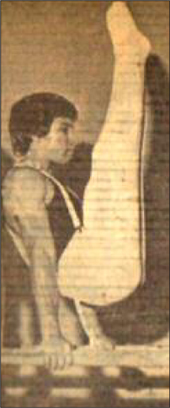
Master RKC Mark Reifkind was one of the top gymnasts in the USA in the 1970s, going head to head with Kurt Thomas. Courtesy Mark Reifkind